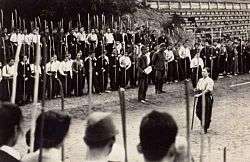Fifty-Second Army (Japan)
The Japanese 52nd Army (第52軍, Dai-gojyūni gun) was an army of the Imperial Japanese Army during the final days of World War II.
| Japanese Fifty-Second Army | |
|---|---|
 Student militia at Kujukurihama, Chiba | |
| Active | April 7, 1945 – August 15, 1945 |
| Country | Empire of Japan |
| Branch | Imperial Japanese Army |
| Type | Infantry |
| Role | Corps |
| Garrison/HQ | Sakura, Chiba |
| Nickname(s) | Shō (捷, Victory) |
| Engagements | Operation Downfall |
History
The Japanese 52nd Army was formed on April 7, 1945, under the Japanese 12th Area Army as part of the last desperate defense effort by the Empire of Japan to deter possible landings of Allied forces in central Honshū during Operation Downfall. The Japanese 52nd Army was based in Sakura, Chiba Prefecture and was thus intended to guard the closest beachhead to Tokyo and the Kantō region along the Bōsō Peninsula. It consisted mostly of poorly trained reservists, conscripted students and Volunteer Fighting Corps home guard militia. It was demobilized at the surrender of Japan on August 15, 1945, without having seen combat.
List of Commanders
| Name | From | To | |
|---|---|---|---|
| Commanding officer | Lieutenant General Shigeta Tokumatsu | 7 April 1945 | 15 August 1945 |
| Chief of Staff | Major General Tamaki Onwa | 6 April 1945 | 10 October 1945 |
References
- Drea, Edward J. (1998). "Japanese Preparations for the Defense of the Homeland & Intelligence Forecasting for the Invasion of Japan". In the Service of the Emperor: Essays on the Imperial Japanese Army. University of Nebraska Press. ISBN 0-8032-1708-0.
- Frank, Richard B (1999). Downfall: The End of the Imperial Japanese Empire. New York: Random House. ISBN 0-679-41424-X.
- Jowett, Bernard (1999). The Japanese Army 1931–45 (Volume 2, 1942–45). Osprey Publishing. ISBN 1-84176-354-3.
- Madej, Victor (1981). Japanese Armed Forces Order of Battle, 1937–1945. Game Publishing Company. ASIN: B000L4CYWW.
- Marston, Daniel (2005). The Pacific War Companion: From Pearl Harbor to Hiroshima. Osprey Publishing. ISBN 1-84176-882-0.
- Skates, John Ray (1994). The Invasion of Japan: Alternative to the Bomb Downfall. New York: University of South Carolina Press. ISBN 0-87249-972-3.
External links
- Wendel, Marcus. "Axis History Factbook". Japanese Fifty-Second Army.